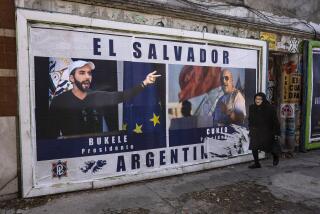There Was a Revolution of Sorts, and Latin America Is Still Feeling It
- Share via
The Cuban Revolution is 40 years old. When Fidel Castro, Che Guevara and the other 1,500-odd members of the Rebel Army and the 26th of July Movement overthrew Fulgencio Batista and entered Havana in January 1959, no one could have predicted or expected that events on the small island could lead to the most severe confrontation of the Cold War; to daring revolutionary escapades throughout Latin America and part of Africa; to a four-decade animosity on the part of the United States, and to Castro’s outlasting the attempts of nine U.S. presidents (Eisenhower, Kennedy, Johnson, Nixon, Ford, Carter, Reagan, Bush and Clinton) to get rid of him.
It is an exceptional feat to have survived at all. The authors of the revolution can take solace in that. But not in much else.
Having once wielded enormous influence on the politics of Latin America, the revolution’s political impact now is limited to the small crowds that still congregate outside the hotels where Castro rests on his sporadic forays into the region. If before Cuba ignited passions of hatred and mistrust or inspired thousands to give their lives for a cause, today it can barely cajole Latin governments to halfheartedly condemn the U.S. embargo against the island.
And yet, despite its ideological isolation and political obsolescence, the Cuban Revolution continues to carry disproportionate weight in the literature, art, academia and cinema of a region whose most distinctive--and redeeming--feature is undoubtedly its cultural vigor.
While this Cuban culture presence is nowhere near what it was 30 years ago or even recently as the 1980s, the island’s sway among writers, singers, painters, academics, poets, actors and television and movie directors is still far greater than its size and resources merit.
The allure for the intellectuals flowed from a somewhat selfish perspective: The revolution gave birth to an intellectual-friendly government that published and rewarded writers, exhibited painters, organized concerts for songwriters and musicians and promoted research and publication for academics.
Today, Cuba’s strategic value is highly reduced: Russia prefers dollars from the International Monetary Fund to Soviet missiles in Cienfuegos pointed at Miami. But hundreds of graduates from Gabriel Garcia Marquez’s School of Cinema and Television in San Antonio de los Banos are scattered across the subcontinent. Every year, dozens of Latin American writers still sit in judgment on novels, essays and poetry at Casa de las Americas, created by the revolution at the very outset, which for years counted among its patrons and friends the greatest literary names in the region.
At the University of Buenos Aires, a Che Guevara chair attracts hundreds of students; its organizers invite--and reject--Argentine writers and interlocutors of Guevara on the basis of their adherence to the party line.
In Mexico, La Jornada, the mass-circulation daily where Carlos Fuentes and Octavio Paz long published their columns on current events, continues to flaunt its enthusiasm for everything Cuban; a not unsimilar case is Argentina’s Pagina 12.
And a smaller-than-ever but nonetheless impressive number of the continent’s most distinguished cultural icons, from Garcia Marquez to Chilean playwright Ariel Dorfman, from Ecuadorian painter Guayasamin to Uruguayan teeny-bopper idol and novelist Mario Benedetti, from Brazilian songwriter and folk hero Chico Buarque to the dean of Latin American sociologists, Mexico’s Pablo Gonzalez Casanova, all remain fast and true friends of Cuba.
The festive times of the Cuban Revolution ended many years ago, as did the heyday of its influence--political, cultural and otherwise--in Latin America history. What remain are memories and regrets, as well as vestiges of a singular experience in Latin America history: the way in which a small island with no particular claim to fame was transformed into a cultural beacon and haven for many of the greatest writers the region has ever known and for some its finest thinkers, musicians and painters.
Hence the paradox: Latin America’s most important political event of the second half of the 20th century has left a much more lasting cultural imprint among novelists than ideologues, among painters than student activists, among musicians than labor organizers--in short among cultural figures than politicians.
More to Read
Sign up for Essential California
The most important California stories and recommendations in your inbox every morning.
You may occasionally receive promotional content from the Los Angeles Times.













